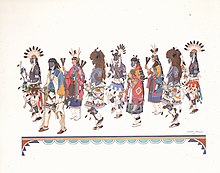
San Ildefonso Pueblo is a census-designated place (CDP) in Santa Fe County, New Mexico, United States, and a federally recognized tribe, established c. 1300 C.E. The Pueblo is self-governing and is part of the Santa Fe, New Mexico Metropolitan Statistical Area. The population was 524 as of the 2010 census, reported by the State of New Mexico as 1,524 in 2012, and there were 628 enrolled tribal members reported as of 2012 according to the Department of the Interior. San Ildefonso Pueblo is a member of the Eight Northern Pueblos, and the pueblo people are from the Tewa ethnic group of Native Americans, who speak the Tewa language.

Maria Poveka Montoya Martinez was a Puebloan artist who created internationally known pottery. Martinez, her husband Julian, and other family members, including her son Popovi Da, examined traditional Pueblo pottery styles and techniques to create pieces which reflect the Pueblo people's legacy of fine artwork and crafts. The works of Maria Martinez, and especially her black ware pottery, are in the collections of many museums, including the Smithsonian, the Metropolitan Museum of Art, the Denver Art Museum, and more. The Penn Museum in Philadelphia holds eight vessels – three plates and five jars – signed either "Marie" or "Marie & Julian".
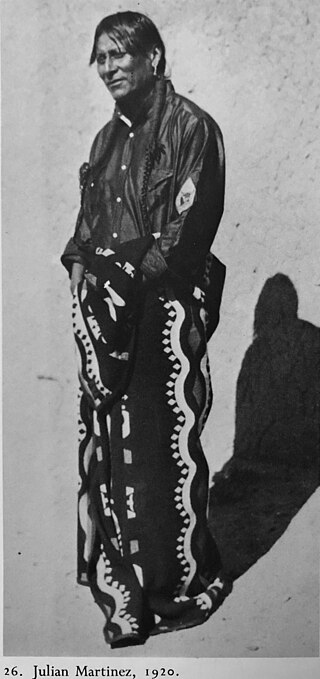
Julián Martínez, also known as Pocano (1879–1943), was a San Ildefonso Pueblo potter, painter, and the patriarch of a family of Native American ceramic artists in the United States.
Jack Hokeah was a Kiowa painter, one of the Kiowa Six, from Oklahoma.
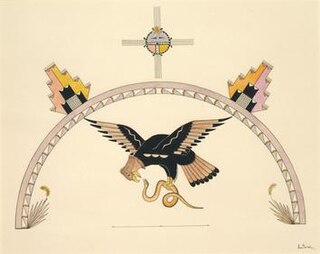
Awa Tsireh, also known as Alfonso Roybal and Cattail Bird, was a San Ildefonso Pueblo painter and artist in several genres including metalwork. He was part of the art movement known as the San Ildefonso Self-Taught Group. His work is held by several museums, including the Smithsonian American Art Museum.
Joe Hilario Herrera, was an American Pueblo painter, teacher, radio newscaster, politician, and a Pueblo activist; from a mixed Cochiti and San Ildefonso background. He was the son of the artist Tonita Peña, and had trained at the Santa Fe Indian School.
Romando Vigil, also known as Tse Ye Mu was a Native American self-taught painter and a leader in the San Ildefonso school. He briefly worked for Walt Disney Studios as a painter and illustrator in the 1950s.
Jose Encarnacion Peña, also known as Encarnacion Peña, and Soqween (1902–1979) was a Native American painter from San Ildefonso Pueblo in Santa Fe County, New Mexico. He is best known for his watercolors of Pueblo ceremonies and he was an early participant in the San Ildefonso school and later in the "Santa Fe Studio Style" art movement.

Waldo Mootzka (1903–1940) was a Hopi watercolor artist.

Emiliano Abeyta (1911–1981), also called Sa Pa, was a twentieth-century Pueblo-American painter from the Ohkay Owingeh tribe. From 1933 to 1934, he was an artist in the Public Works of Art Project as part of the New Deal. Already an established artist by that time, he worked for the program out of the Santa Fe Indian School in Santa Fe, New Mexico. Later, in the 1950s, his work was part of the University of Oklahoma European Tours, for which the university's College of Fine Arts curated a collection of paintings for the U.S. Information Service to exhibit across Europe. Abeyta's work is in the permanent collection of the Smithsonian National Museum of the American Indian and the University of Oklahoma.
Alfred Aguilar, also called Sa Wa Pin, is Tewa Pueblo-American potter, ceramicist, and painter from the San Ildefonso Pueblo tribe. He is known for his coil-built pottery that is carved or painted, his buffalo figurines, and his clay nacimientos.

José Vicente Aguilar, also called Sua Peen, is a Pueblo-American painter of San Ildefonso Pueblo and Picurís Pueblo heritage. He is known for his watercolor paintings. Aguilar has exhibited across the United States, particularly in the Southwest, and his work is in the permanent collection of institutions including the Gilcrease Museum.
Josefa Roybal sometimes known as Josephine or Josepha, was a 20th-century Native American artist, a San Ildefonso Pueblo painter and potter. According to one source, she "most likely was born between 1900 and 1905 and most likely died before 1960."
Pat Atencio, also called Koo Peen, was a San Ildefonso Pueblo painter.
Tony Atencio, also called Su Ta, was a San Ildefonso Pueblo painter. He studied at the Santa Fe Indian School and exhibited his work across the country. He is known for his paintings of animals.

Isabel M. Montoya Atencio (1899–1996) was a San Ildefonso Pueblo painter and potter.

Lorencita Atencio Bird, also called T'o Pove, was a Pueblo-American painter and textile artist from the Ohkay Owingeh Pueblo. She studied at the Santa Fe Indian School under Dorothy Dunn and exhibited her artwork across the country and in Europe. In particular, she is known for her embroidery designs, utilizing symbolic colors and motifs such as diamonds, butterflies, and the color gold. Her artworks can be found in private collections including the Margretta S. Dietrich Collection and in museums including the Heard Museum, the Gilcrease Museum, the Philbrook Museum of Art, and the Wheelwright Museum of the American Indian.

Oqwa Pi also known as Abel Sanchez (1899–1971), was a San Ildefonso Pueblo painter, muralist, and politician. Pi was known for his brightly colored paintings. He served as governor of the San Ildefonso Pueblo for six terms.
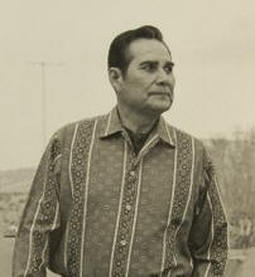
Popovi Da (1923–1971) was a San Ildefonso Pueblo Native American potter. He was also known as Tony Martinez. As an artist he worked as a collaborative team with his mother, the noted Tewa potter, Maria Martínez, and also independently on his own works. He served six terms as Governor of San Ildefonso Pueblo beginning in 1952.
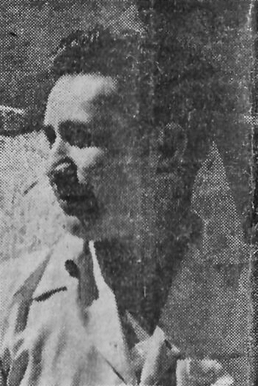
Percy Tsisete Sandy, was a Zuni artist. His native name was Kai-Sa ; he is also known as Percy Sandy Tsisete. His paintings were signed with the name Kai-Sa.
